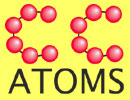
 |
| Home | About | Software | Curriculum | Research |
| Contents of About: About the Project | Proposal |
Home Page ![]() About CC-ATOMS
About CC-ATOMS ![]() Proposal
Proposal ![]() ITR Proposal: Goals and Objectives
ITR Proposal: Goals and Objectives
| Proposal Contents: |
GOALS, OBJECTIVES, AND SIGNIFICANCE
The overall goal of this project is to develop and evaluate
the use of complex, interactive computational models in the real-world
situations encountered in two-year college technical programs.
The project will develop a set of related, flexible atomic-scale
models as well as the software architecture that supports the
rapid development and deployment of educational materials that
utilize these models. We will pilot test this technology in two-year
college courses by providing a range of hypermodels that use atomic-scale
models to illustrate key science topics in the context of typical
technical specialties. We will identify a set of key science topics
typically taught in biology, chemistry, and physics courses at
this level and generate hypermodels for each that are based on
technologies and processes used in specialty programs. Using WISE,
the hypermodels will be integrated into complete online instructional
units that faculty can adapt to their needs. The Web-based units
will be designed to be easily inserted into courses without significant
changes in the organization or learning objectives of current
instruction. They will all, however, have a consistent, atomic-scale
approach that could be the basis of a new, interdisciplinary approach
to the core sciences, of the type advocated by Nobel laureate
Leon Lederman (1999).
The units will be tested in two-year technical colleges throughout
the country. Student understanding of the content and ability
to transfer this understanding to new contexts will be measured
through a combination of online and in-class evaluation techniques.
The architecture, models, tools, modules, and findings will be
widely disseminated.
The proposed units are illustrative of a larger class of models
and tools that could make an important contribution to improved
education at the two-year technical colleges as well more generally
in education at all levels. If the proposed work with atomic-scale
models proves promising, additional models that capture other
core science phenomena might be developed. These might include
models of fluid dynamics, electrical circuits, and classical mechanics
as well as tools for real-time data acquisition, graphical analysis,
and data mining all of which could all be wedded to the Pedagogica/WISE
architecture developed for this project. The resulting materials
could revitalize all aspects of mathematics, science, and engineering
education. This architecture would support a wide range of materials
using inquiry-based instruction and embedded assessment that faculty
could easily create and modify, share, and disseminate. The importance
of this project is to test this architecture and delivery as well
as the feasibility and desirability of using models of these type
in two-year college science courses.
(The following section will cover prior research on the Molecular
Workbench project and software that forms the basis of the present
proposal.)

This material is based upon work supported by the National Science Foundation under Grant No. EIA-0219345. Any opinions, findings, and conclusions or recommendations expressed in this material are those of the author(s) and do not necessarily reflect the views of the National Science Foundation.
Last Update: 12/10/2018 Maintainer: webmaster@concord.org
Site Map
Copyright © 2018, The Concord Consortium.
All rights reserved.